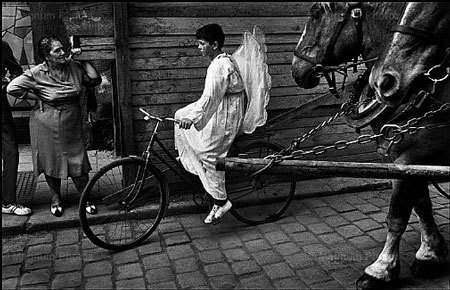 Josef Koudelka was born in 1938 in Boskovice, Moravia. He began photographing his family and the surroundings with a 6 x 6 Bakelite camera. He studied at the Czech Technical University in Prague (CVUT) between 1956 and 1961, receiving a Degree in Engineering in 1961. He staged his first photographic exhibition the same year. Later he worked as an aeronautical engineer in Prague and Bratislava.
Josef Koudelka was born in 1938 in Boskovice, Moravia. He began photographing his family and the surroundings with a 6 x 6 Bakelite camera. He studied at the Czech Technical University in Prague (CVUT) between 1956 and 1961, receiving a Degree in Engineering in 1961. He staged his first photographic exhibition the same year. Later he worked as an aeronautical engineer in Prague and Bratislava.He began taking commissions from theatre magazines, and regularly photographed stage productions at Prague's Theatre Behind the Gate on a Rolleiflex camera. In 1967, Koudelka decided to give up his career in engineering for full-time work as a photographer.
He had returned from a project photographing gypsies in Romania just two days before the Soviet invasion, in August 1968. He witnessed and recorded the military forces of the Warsaw Pact as they invaded Prague and crushed the Czech reforms. Koudelka's negatives were smuggled out of Prague into the hands of the Magnum agency, and published anonymously in The Sunday Times Magazine under the initials P. P. (Prague Photographer) for fear of reprisal to him and his family.
His pictures of the events became dramatic international symbols. In 1969 the "anonymous Czech photographer" was awarded the Overseas Press Club's Robert Capa Gold Medal for photographs requiring exceptional courage.
With Magnum to recommend him to the British authorities, Koudelka applied for a three-month working visa and fled to England in 1970, where he applied for political asylum and stayed for more than a decade. In 1971 he joined Magnum Photos. A nomad at heart, he continued to wander around Europe with his camera and little else.
Throughout the 1970s and 1980s, Koudelka sustained his work through numerous grants and awards, and continued to exhibit and publish major projects like Gypsies (1975) and Exiles (1988). Since 1986, he has worked with a panoramic camera and issued a compilation of these photographs in his book Chaos in 1999. Koudelka has had more than a dozen books of his work published, including most recently in 2006 the retrospective volume Koudelka.
Koudelka has won awards such as the Prix Nadar (1978), a Grand Prix National de la Photographie (1989), a Grand Prix Cartier-Bresson (1991), and the Hasselblad Foundation International Award in Photography (1992). Significant exhibitions of his work have been held at the Museum of Modern Art and the International Center of Photography, New York; the Hayward Gallery, London; the Stedelijk Museum of Modern Art, Amsterdam; and the Palais de Tokyo, Paris.
He and his work received support and acknowledgment from his friend the French photographer, Henri Cartier-Bresson. He was also supported by the Czech art historian Anna Farova.[1]
In 1987 Koudelka became a French citizen, and was able to return to Czechoslovakia for the first time in 1991. He then produced Black Triangle, documenting his country's wasted landscape.
Koudelka resides in France and Prague and is continuing his work documenting the European landscape. He has two daughters and a son.

Nenhum comentário:
Postar um comentário